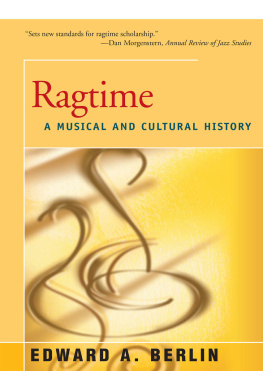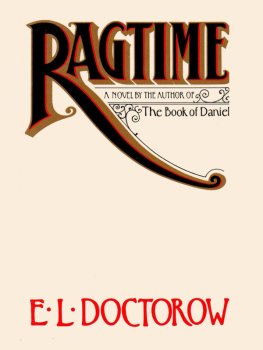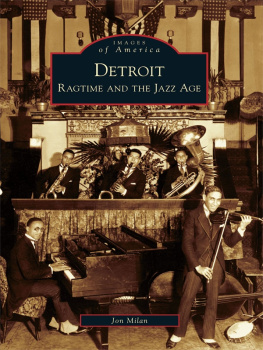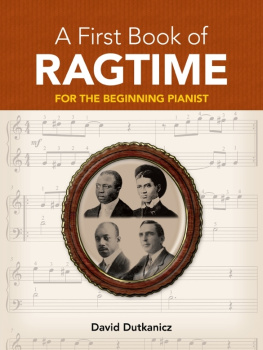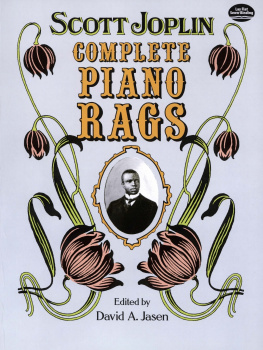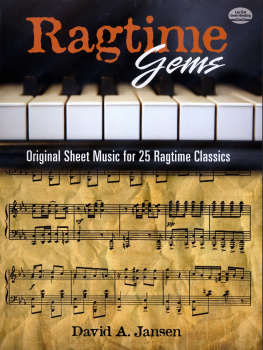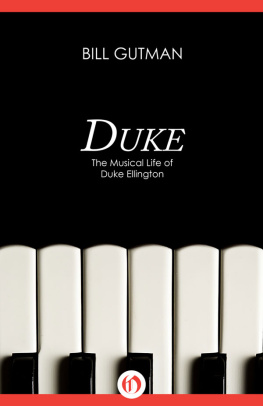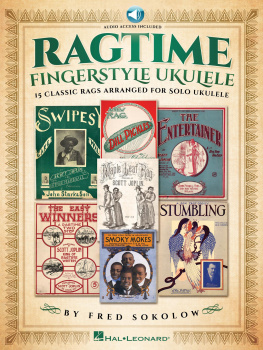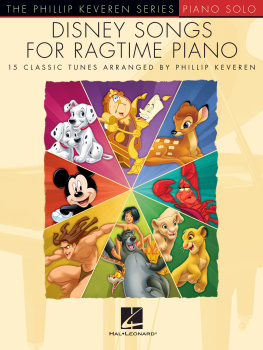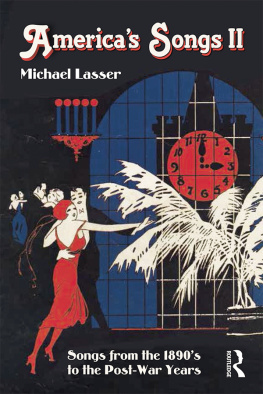Ragtime
A Musical and Cultural History
Edward Berlin
To
Andre, Michle
Stephanie, and Kim
Preface
The resurrection of ragtime in the 1970s is a phenomenon unprecedented in Americas musical history; never before has a long-buried style been so widely and eagerly embraced by a mass public. For some this has been, at least partially, a nostalgic trip to the simplicity and charm of the past, but for the majority, indifferent or oblivious to ragtimes historicity, this enthusiastic reception has been in response to the same musical qualities that so intrigued Americans seventy years ago: ragtimes direct melodic and harmonic message, its irresistible, foot-tapping, rhythmic impulse.
At the time of this writing, the ragtime fervor has peaked; it is no longer in (and on) the air so unremittingly as it was three and four years ago; it is no longer in such incessant demand. But neither is it returning to its former niche of historical obscurity. Madison Avenue ad agencies continue to milk ragtime for its cheerful ebullience; piano (also harpsichord and organ) recitalists are still daring to program Joplin, Scott, and Lamb in the rarified company of Chopin, Mozart, and Scarlatti. And although many of those whose conviction and actions brought about the revivalamong those most prominent, Joshua Rifkin, William Bolcomb, Vera Brodsky Lawrence, Gunther Schullerare now occupied with new concerns, othersMax Morath, Rudi Blesh, and the small coterie of dedicated, hard-line ragtimers who kept the music alive during its leaner yearsremain faithful to the cause, and are now buttressed by a greatly enlarged corps of fans and scholars who are both demanding and bringing to ragtime studies a new intensity and perspective.
Much of the literature that has accompanied and followed the ragtime revival has been blatantly exploitative, works promising to fulfill the thirst for information created by the revival but offering only reruns of earlier writings, works which have the further pernicious effect of uncritically perpetuatingoften in defiance of simple logicworn-out myths and unsupported truisms. One can, of course, also find among recent literature a few works of true merit, sincere efforts that reflect original research and insight. The main emphasis in both categories, though, has been on personalities, especially on Scott Joplinthe revivals main focusand others touched by his influence. This emphasis, in itself unobjectionable, has brought to light what may be the best in ragtime and has stimulated investigation into peripheral areas. What the critical reader misses, and what is available in the scholarship of most other styles, is substantive discussion, in musical terms, of the genre and its evolution, and of its position in the panorama of American music and culture. It is with a recognition of these deficiencies that the present book was begun.
Initially, my intent was to make a stylistic study, to take a broad look at the scope of ragtime music and to fill in the background required for a historical understanding and evaluation of the music. To this end I examined over 1,000 piano rags, analyzing each piece individually and statistically, as well as an uncounted number of vocal rags and other related music. From this accumulated data emerged the course of ragtimes evolution and its relationship to other music of the period.
A major question that emerged in the course of this musical survey was how to determine what music could reasonably be considered ragtime. Along with the hundreds of unproblematic examples that possess the musical traits of ragtime (or more properly, my conception at that time of what these traits should have been) and are clearly labeled as such, are numerous pieces that, while failing to match these criteria, could not automatically be discarded: works that display ragtime characteristics but are without the proper label; works designated as rags but lacking the expected musical traits; works that have neither the expected traits nor a specific label, but which were apparently considered by contemporaries to be rags. In an attempt to sort out these various categories and to learn how ragtime was viewed sixty to eighty years ago (and disregarding the advice of a prominent ragtime authority who insists that the public of that time had no understanding of ragtime), I consulted the books, magazines, and newspapers of the period. The abundance and breadth of literature was totally unanticipated: hundreds of articles discussed ragtime in relation to a broad scope of musical, aesthetic, and social issues. My original search for a working definition of ragtime was almost dwarfed as I became immersed in the conflicts of its day concerning ragtimes origins, racial content, relevance to American music, innovative features, potential for artistic development, effects on cultural, moral, and physical well-being, and the like. What had begun as a preliminary, minor investigation gradually assumed major proportions, adding perspective to an understanding of the music as well as significant insights into aesthetic and sociological issues transcending the immediate concerns of ragtime.
The realization of how greatly the original conceptions of ragtime differ from those of the present day prompted yet another area of investigation. This inquiry, the final third of the study, traces commentary to the present in an effort to detect the reasons for the altered attitudes and the means by which these changes were effected.
This book presents views that differ markedly from those expressed in other histories of ragtime, and it will undoubtedly disturb a few partisans who find their cherished beliefs without support. My intent has been to permit the investigation to unfold without prejudice, to reflect the available evidence and documents, and to depict, as closely as possible, what actually was rather than what some wish might have been. I do not expect (or even desire) complete agreement with my ideas, and I readily admit the plausibility of alternative interpretations of some of the data. But I do hope, most fervently, that my efforts will help remove ragtime studies from the domain of vague intuition and romantic fantasy, and direct it toward a path of greater critical scrutiny.
Part One
The Ragtime Era: Perceptions of the Music
In 1974, seventy-two years after its publication, Scott Joplins piano rag The Entertainer swept the country, reaching the number three spot in Billboards survey of best-selling recorded singles. Promoted by the award-winning film score for The Sting, this piece led the return of ragtime to a prominence in American popular culture unequaled since the first two decades of the century.
The present interest does not quite parallel the original ragtime phenomenon, for the musical emphasis has shifted. Had Billboard made a survey of favorite rags in 1902, the list probably would have included Mister Johnson Turn Me Loose, All Coons Look Alike to Me, My Coal Black Lady, Hello! Ma Baby, and Under the Bamboo Tree. All songs! Today, in contrast, ragtime is generally thought of as piano music, especially that of Scott Joplin, Joe Lamb, James Scott, and a few others. While such recorded ensemble versions as The Red Back Book have demonstrated how vibrant ragtime can be in other media, the keyboard remains at the center of the present-day conception of the genre.
Clearly, if the contemporaries of that past period perceived ragtime as primarily a vocal form, then ours is an altered view. Nor is the view of ragtime as predominantly a music for piano held only by an uninformed lay public; it is expressed also in respected studies of American music:

